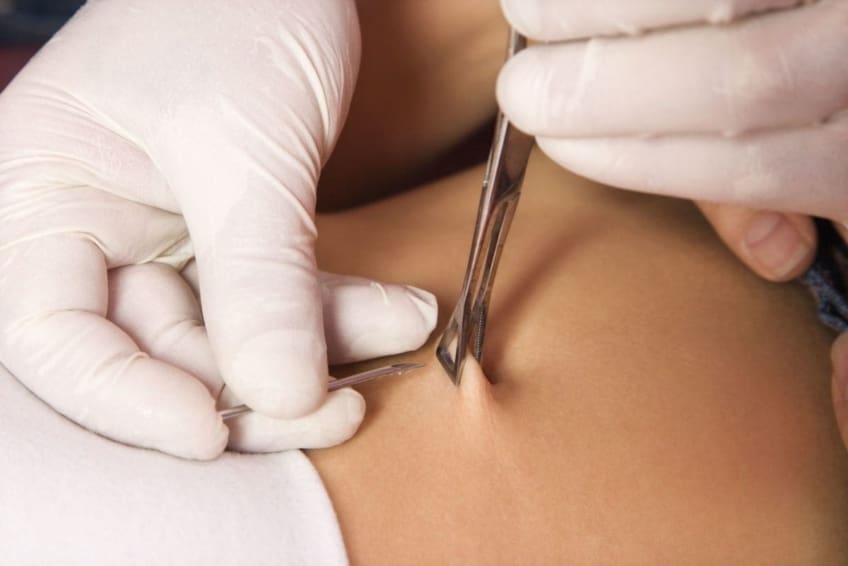
Body piercing is when a hole is made in your body so you can add a piece of jewelry for decoration. The earlobe is the most common body piercing. Some people also pierce their ear cartilage (the hard part of the outer ear). Other places to pierce include the eyebrow, nose, tongue, lip, belly button, nipples, and genitals.
Path to improved health
Piercings should always be done in a clean environment using sterile (clean and germ-free) equipment. This is the best way to lower your risk of infection..
How is piercing performed?
A single-use, sterilized piercing gun is typically used to insert an earring into the earlobe. For other parts of the body, a hollow needle is used to pierce a hole in the skin. The person doing the piercing will insert a piece of jewelry into the hole.
The safest piercing guns are single-use guns. That means it’s only used on one customer and then thrown away. This decreases the risk of infection. Piercing guns with sterilized disposable cassettes are also acceptable. But they don’t promise the same level of protection that single-use piercing guns do.
Don’t receive a piercing from a reusable piercing gun that does not have sterilized disposable cassettes. These types of piercing guns cannot be autoclaved. An autoclave is a sterilization machine that uses heat to sterilize all non-disposable piercing tools. It helps make sure all tools are clean before they touch your body. It is an important piece of equipment in a clean piercing shop. Not being able to autoclave a piercing gun increases the risk of infection.
Also, don’t have a piercing performed with a piercing gun on any part of your body except your ear. Doing so can crush the skin and cause more injury than a piercing performed with a hollow needle.
Who should perform my body piercing?
Before getting a piercing, do some research. Find a clean, safe piercing shop. Choose a professional with a good reputation to perform the piercing.
Do not pierce yourself or let anyone pierce you who is not a professional. Select the body site and jewelry carefully. Avoid jewelry made of nickel or brass. These metals can cause allergic reactions. Look for jewelry made of titanium, 14-carat gold, or surgical-grade steel.
The person doing the piercing should:
- Wash his or her hands well with a germicidal soap before doing the piercing.
- Wear disposable gloves.
- Use disposable or sterilized tools.
- Use a new needle for each piercing.
Things to consider
Health risks from body piercing include:
- Allergic reactions
- Keloids (a type of scar that forms as your skin heals)
- Infection
Infection is the most common problem you may have after getting a piercing. People have a hard time recognizing if their piercing is infected. They confuse the infection for a piercing that is healing.
Call your doctor if you experience any of these infection symptoms:
- Fever
- Red, swollen skin around the pierced area
- Pain when touching the pierced area
- A yellowish, foul-smelling discharge coming from the piercing
What increases my risk of problems from body piercing?
Many things can affect your body’s immune system and your ability to fight infection. Be sure to tell the person piercing you if you have diabetes, heart problems, a weakened immune system, or any other medical conditions. If you take steroids or blood thinners, talk to your doctor before getting a piercing.
How can I prevent an infection?
Make sure you take care of your piercing. The person performing your piercing will recommend cleaning the area with soap and warm water twice a day while it heals. You will also be instructed to use a liquid medicated cleanser while gently moving the piercing around. For a tongue or lip piercing, you will need to use an antibacterial mouth rinse after meals to prevent infection while it heals.
When to see a doctor
It’s very important to see your doctor if you think you might have an infection. Delaying treatment can result in a more serious infection. Don’t remove your piercing jewelry unless your doctor tells you to do so. Leaving the jewelry in can ensure proper drainage. It will also prevent an abscess (a collection of pus) from forming. Most times, the infection can be treated without losing the piercing.
Minor infections may be treated with the following:
- Over-the-counter medicines you rub on your skin, such as an antibiotic ointment
- A warm compress applied to the piercing
- Mild sea salt soaks
Questions for your doctor
- Could I have been exposed to a disease while being pierced?
- How do I know if I’m allergic to the metal in my piercing jewelry?
- Will my piercing leave a scar if I take it out?
- What is a keloid? Is there a way to get rid of it?
![]()
Copyright © American Academy of Family Physicians
This information provides a general overview and may not apply to everyone. Talk to your family doctor to find out if this information applies to you and to get more information on this subject.




